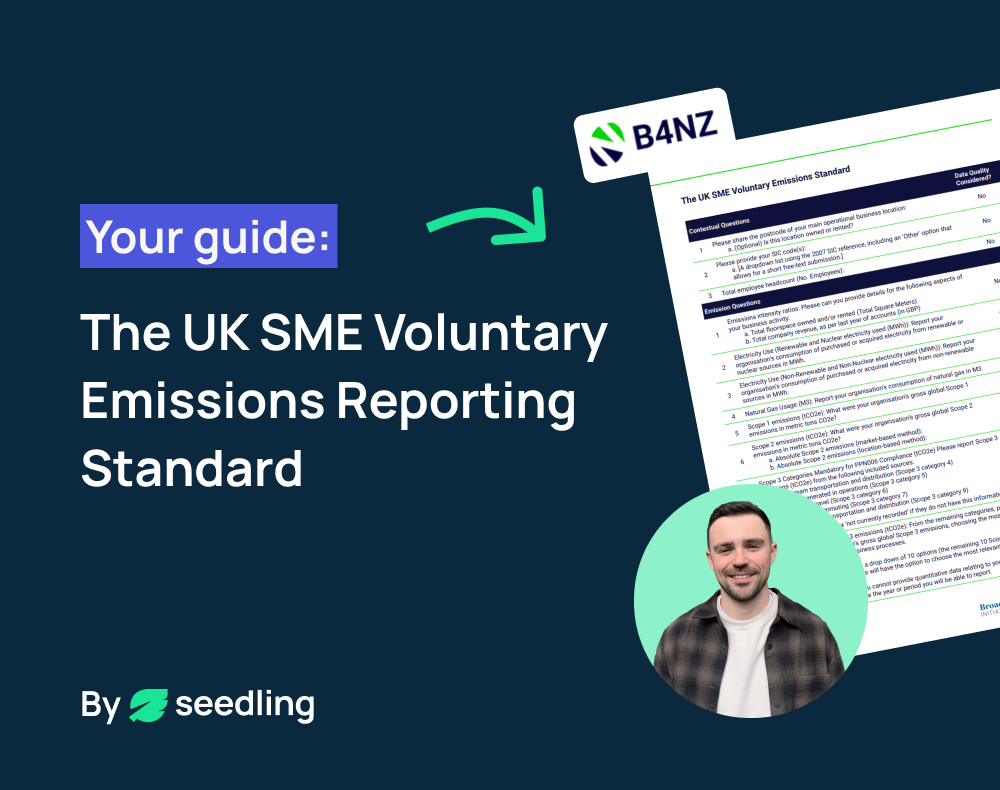What is the UK SME Voluntary Emissions Standard?
The UK SME Voluntary Emissions Standard is a new way for small and mid-sized businesses to share a minimum, comparable set of carbon and energy data with customers, banks, and insurers.
The aim is simple: reduce duplication, improve trust, and help turn sustainability reporting into something useful for winning work and unlocking finance. The standard is led by Bankers for Net Zero (B4NZ) and the Broadway Initiative through the SME Sustainability Data Taskforce, in partnership with government via the Net Zero Council.
Under the hood, the standard is formatted as a short set of questions and metrics that look the same wherever they go. That consistency is what makes the data easier to use across supply chains and by lenders.
When was the standard released?
Version 1 launched in summer 2025 and entered a national consultation and testing phase, with a companion guidance pack published in July 2025. External briefings and policy summaries throughout late summer confirmed the launch and the intent to road-test with banks and buyers before wider adoption.
Who released it and why?
Bankers for Net Zero convenes finance, industry and policymakers to remove barriers to SME decarbonisation and green finance. With the Broadway Initiative as co-secretariat, they set up the SME Sustainability Data Taskforce to develop a “create once, share many” disclosure that works for SMEs and their counterparties.
What's motivating them? In plain terms, they want to achieve four things:
- Provide a single, practical disclosure SMEs can complete once and share many times.
- Improve comparability for data requesters, so they are not each asking in slightly different ways.
- Build a trusted route for banks to use real SME data in green and sustainability-linked products.
- Align with public procurement expectations to avoid rework across bids.
The guidance lays out consistent questions and explains why each one is included. You’ll capture location and SIC code, headcount, floor space and revenue for intensity metrics, energy use, Scopes 1 and 2, and relevant Scope 3. There’s space for your Net Zero target, recent actions, and leadership sign-off. The questions are designed so the same disclosure can serve buyers, banks and insurers without constant re-keying (Bankers for Net Zero).
What this might mean in practice: cheaper finance
Lenders say they struggle to get sustainability data from SMEs that's useful for decision-making. The standard is meant to solve that by supplying better primary data and a way to judge quality. That helps banks design green finance, price risk more fairly, and connect loan terms to credible decarbonisation performance.
How is data quality assessed?
Every data point in your submission gets a quality classification. Level 1 is live and validated contributed data. Level 2 is primary data you provided that isn’t yet independently validated. Levels 3 and 4 are modelled estimates based on limited attributes.
The higher your share of Level 1–2 data, the higher the trust in your figures. Higher trust reduces perceived risk, which can support better pricing for products like Sustainability-Linked Loans. Better data, better rates (in theory).
The scale is applied to each attribute rather than the whole submission. That means you can move electricity to Level 1 by connecting metered data while you improve other areas over time. Hybrid grading is expected in year one. The intent is to reward progress, not perfection.
How will SMEs actually comply?
Good news: much of this is familiar if you’ve produced a Carbon Reduction Plan for UK public sector bids under PPN 006. Through engagement with the Cabinet Office, the taskforce aligned core questions so a submission under the SME Standard can map into PPN requirements. In the current guidance, five Scope 3 categories that underpin PPN have been made “mandatory to respond,” with a “not currently recorded” option to keep it proportionate while the market levels up.
Expect to compile:
- Emissions data across Scopes 1, 2 and a subset of Scope 3 (aligned to PPN 006).
- Energy data for electricity and gas.
- Intensity metrics like floor space, FTEs and revenue.
- A Net Zero target and any interim goals.
- A short note of reduction initiatives and progress.
- Leadership sign-off and an accuracy affirmation. Bankers for Net Zero
If you want a more detailed run-through with the rationale for each item, the “From Burden to Benefit” report is a solid overview, with appendices that show how the questions were chosen and how the data quality scale will be applied in practice.
What’s next?
2025 is about consultation and testing with banks, buyers and SMEs. Trade bodies and networks are already running test cohorts. Expect continuing alignment work with PPN 006 through early 2026 and a push for broader adoption after that.
Keep an eye on B4NZ updates and sector associations that are piloting the standard in their supply chains.
How Seedling helps
This is where we can make your life easier. Seedling already collects the data the standard expects, ensures your footprint aligns with the GHG Protocol, and packages outputs your clients and lenders can use. Our platform and expert support help you move from spend-based estimates to activity-based data so reductions show up properly. We also generate Carbon Reduction Plans for PPN 006 and B Corp-aligned Climate Transition Plans. In short: we’re aligned with the new standard and ready to help you roll it out as adoption grows.
Start Measuring Your Carbon Footprint Free Today
Free forever. No Credit Card required.
Benchmark your business’s climate action for free

Chat to an expert

Measure a full-scope footprint, reduce emissions, and share your Net Zero strategy.

.png)



.svg)


